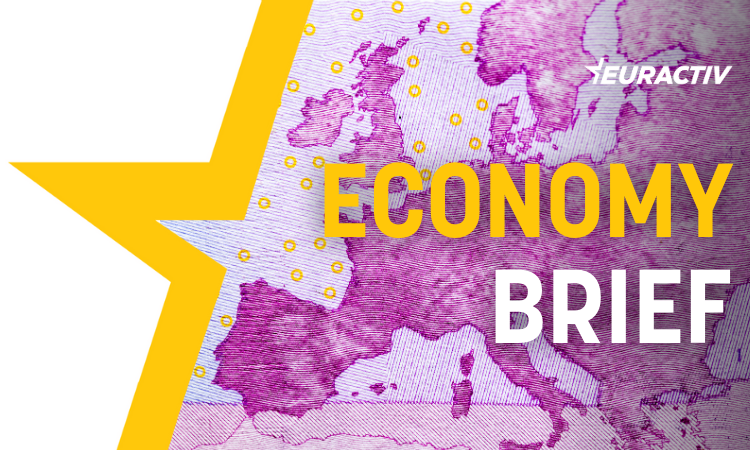
Welcome to EURACTIV’s weekly Economy Brief. You can subscribe to the newsletter here.
In recent months, calls to complete the EU’s Capital Markets Union (CMU) have become more frequent, but it’s not always clear whether the CMU’s most recent supporters really want a more integrated financial market or whether they just use the vagueness of the term to hide other political objectives.
Take, for example, German Finance Minister Christian Lindner. Speaking to German members of parliament at the end of September, he argued for the CMU as a means for the green transition as opposed to using public money.
According to him, the EU had more public money on the table than the US: “Our problem is the private capital that we have to mobilise.”
Thus, the CMU works as a wonderful argument against the use of more public money – very convenient for the fiscal hawk in the German government.
In an op-ed published together with French Finance Minister Bruno Le Maire, Lindner fleshed out what he means by the CMU. Among measures to make securitisation and public listing easier, they also mentioned that the EU should avoid “measures that could limit [retail investors’] access to financial advice.”
This is a nod to the EU’s retail investment strategy, in which the EU Commission originally wanted to ban inducement-based financial advice. This is a form of financial advice that is “for free” at the moment of advice, but on average leads to worse and more costly results for retail investors, as financial advisers suggest products for which they get the highest commissions and not those best for retail investors.
Incidentally, this model of financial advice is very widely used by German banks and after fierce lobbying by Lindner and his Austrian counterpart, the EU Commission finally proposed a retail investment strategy that would not ban the inducement-based model.
In his op-ed, Lindner was able to defend the interests of German banks in the name of the CMU.
However, the CMU can also be used to argue for political measures that Lindner would not approve of, for example, more common EU debt.
According to the European Central Bank’s Fabio Panetta, a true CMU would need a “European Safe Asset” that could play the role that US treasury bonds play in the US capital markets.
“Historically, mature capital markets have been built around a public safe asset,” he wrote in a blog post arguing that a risk-free benchmark would allow for better pricing of risky financial products and thus make trading easier and less costly.
In early September, the president of the insurance company Generali Group Andrea Sironi also backed Panetta’s argument, and last week Enrico Letta, who is charged with writing a report on the future of the EU’s Single Market, also spoke in favour of it in an interview with Euractiv.
Two weeks ago, ECB President Christine Lagarde also argued in this direction, floating the idea of a “green CMU”, underpinned by a European green bond.
Thus, the CMU also works as a good argument for more public spending at the European level, quite the opposite of what Lindner wants.
Asset managers, meanwhile, argue that a CMU is only possible if tightly regulated pension and insurance funds are deregulated to allow for riskier investments. Where else would the money come from?
So, the CMU can also be put forward as an argument for pension fund deregulation.
This does not mean that the arguments are wrong. But the ease with which the CMU can be used to argue for stuff that politicians like for other reasons than the CMU itself should make us sceptical of its use as an argument.
The EU is worried about its car industry. For too long, European car manufacturers have relied on the internal combustion engine and now that the electric car seems to be the future, the EU risks losing its advantage and being taken over by its Chinese competition.
At least that’s the story. But what does the data say?
Taking a look at all EU car sales based on data from the European Automobile Manufacturers’ Association, European manufacturers are indeed losing ground. From 2019 to 2022 European manufacturers lost four percentage points in market share in their home market.
However, Chinese manufacturers are only a part of the problem, having increased their market share from 0% to 1.3%. The rest of the European market share was grabbed by other foreign brands. As Euractiv’s Jonathan Packroff recently wrote: The EU is far from being flooded with Chinese cars.
The picture is different if we look at car sales in China (you can change the tab in the chart above). While European brands have lost a little more than four percentage points as well, Chinese brands have increased their home dominance significantly.
Meanwhile, the most interesting market is the one for electric vehicles (EVs) as it might indicate who will dominate the car industry of the future. The chart below shows the market share of European brands in the Chinese EV market as well as the market share of Chinese brands in the European EV market.
At first sight, all seems good for the European manufacturers since their market share is higher, even if the Chinese graph seems to jump up quite significantly in 2022.
The market shares look more worrying from a European perspective if we compare the European brands’ market share in total car sales vs their market share in EV sales, as the chart below does.
In 2022, European brands had a market share of 24% in the Chinese car market. But in the Chinese EV market, their market share was only at 6.1%. If the future is electric, the European manufacturers risk losing a big chunk of Chinese business.
On the other hand, the Chinese market share in European EV sales is higher than its market share in total European car sales, setting Chinese brands up for an advantageous outlook.
Whether the EU investigation into Chinese EV subsidies can materially change this picture, remains to be seen.
You can find all previous editions of the Economy Brief Chart of the week here.
No agreement on fiscal rules in sight. While the Spanish Presidency of the EU Council had originally hoped for an agreement on the reform of the EU’s economic governance and thus its fiscal rules in October, diplomats of different EU member states told EURACTIV that this was increasingly unlikely. Ahead of a meeting of EU finance ministers next Tuesday (17 October), Germany is insisting on stricter numerical benchmarks while France and Italy are insisting on allowing governments to invest more. The goal of Tuesday’s meeting has thus been downscaled: Ministers will only have a policy discussion, instead of aiming for an agreement.
Member states agree on measures to boost the social economy sector. On 9 October, EU ministers reached a political agreement on a proposed recommendation which seeks to step up support for the social economy, in particular by easing access to public and private funding. The recommendation, which sets non-binding objectives, will need to be formally approved by the Council and implemented within two years.
EU Parliament’s budget and industry committees approve STEP position. Both committees voted on Monday (9 October) in favour of creating a Strategic Technologies for Europe Platform (STEP) with a broader scope than the European Commission proposal and more fresh cash from member states. Read more.
EU lawmakers approve position on 2024 EU budget ahead of plenary vote. On Monday (9 October), members of Parliament’s budget committee adopted the report on the EU budget for 2024, leaving open the possibility to amend the text before the plenary vote next week in light of the situation in Israel. “We will look into the budgetary implications linked to Palestine and if there is anything from the EU budget that we feel has to be put in question or frozen or put in reserve as a consequence of the start of this war, we are going to propose respective amendments for the plenary,” rapporteur Sigfried Muresan said.
MEP urges member states to accelerate work on new resources for the EU budget. “There’s no more time to waste on agreeing and implementing new own resources for the EU budget,” said José Manuel Fernandes, co-rapporteur on income resources for the EU budget, on Monday (9 October). Fernandes called on member states to agree quickly on the Commission’s proposal for new resources presented in June, but EU countries remain reluctant to adopt new revenue streams.
EU Commission worried about ageing population. The EU Commission called on member states to adapt all their policies to the longer life expectancies of citizens, but it did not make any concrete proposals and shied away from tackling controversial topics such as an increase in retirement ages. Read more.
Europe’s tech regulation is not an economic policy
Why Women Won (by Nobel laureate Claudia Goldin)
Stalled by design: New paradoxes in the European Union’s single financial market.
Money and the public debt: Treasury market liquidity as a legal phenomenon
What will it cost the European Union to pay its economic recovery debt?
Additional reporting by Silvia Ellena, Sean Goulding
[Edited by Zoran Radosavljevic]







